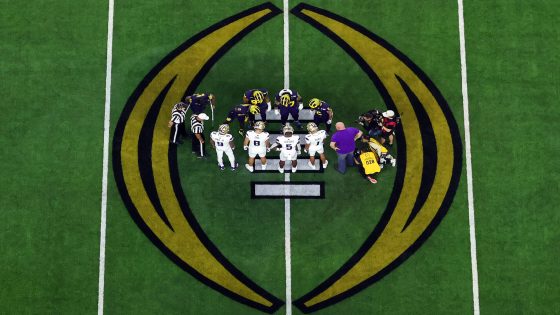The NCAA Playing Rules Oversight Panel on Friday officially approved the use of helmet communication and sideline tablets in the Football Bowl Subdivision, as well as a two-minute warning.
The changes were proposed by the NCAA’s football rules committee on March 1 and were expected to be approved. Friday’s decisions were the final rubber stamps, coming after a successful trial run by several teams using the technology in bowl games.
Teams will be allowed to have one player on the field with the helmet communication technology, which will be signified by a green dot on the helmet like the NFL, which first used helmet tech in 1994. According to the policy recommendation obtained by The Athletic, teams can bring up to 10 coach-to-player devices to a game, and teams must submit a list of device-eligible players to the conference office no later than the pregame meeting.

GO DEEPER
NCAA rules committee proposes helmet communication, 2-minute warning
A team can use the helmet tech even if the opponent chooses not to use it. Conferences will select their vendor of choice, according to the policy, keeping everyone in a conference with the same company. GSC (which supplies the NFL helmet tech) and CoachComm (which handles coach headsets for most teams) are expected to be the main vendors.
The communication will shut off with 15 seconds left on the play clock or when the ball is snapped, whichever is first. The cutoff operator will be hired, assigned and managed by the conference. If one team’s operations go down, both teams will cease using the communication.
This technology rule change was not a response to Michigan’s sign-stealing scandal, which was revealed after the Big Ten first proposed this rule last summer. This is also not expected to end sideline signals or sign-stealing, especially for up-tempo teams that need to feed a play into wide receivers quickly, but it is a step toward an easier process.
Some coaches have expressed a desire for more communication-eligible players on the field. There were no limits during the bowl trial run, and that in some cases did eliminate signaling. But the rules committee didn’t want to go further than the NFL at this point.
“The intent is to get a little closer to what the NFL has done to allow communication,” Georgia head coach and committee co-chair Kirby Smart said last month. “It’ll allow communication with a quarterback and someone on defense, and we’ll find out where it takes us.”
Sideline tablets
The panel also approved the use of tablets to view in-game video only for all three football divisions. The video could include the broadcast feed and camera angles from the sideline or end zone, and teams could use up to 18 tablets total. This is slightly different from the NFL, which allows only images on tablets.
The tablets are not allowed to have data or other communication access. DVSport, which handles film for most teams, is expected to be the vendor of choice for most schools.
Several state high school associations have allowed tablets for years, meaning college football is only now catching up.
Two-minute warning
The addition of a two-minute warning for the second and fourth quarters like the NFL will be the most noticeable change for fans. It will be a fixed point for a media timeout but not a new media timeout. The hope is it will prevent broadcasters from using back-to-back TV timeouts (touchdown, commercial, kickoff, commercial). It will also allow officials to switch to the rule changes that happen in the final two minutes, such as the running clock after first downs and out-of-bounds plays.
“This is not a new or additional timeout,” rules committee co-chair and Big Ten VP of football administration A.J. Edds said last month. “This is a known position that will hopefully alleviate the impression early in the quarters where media partners have taken breaks in consecutive opportunities. This will give them a larger runway over the second and fourth quarters.”
It will also change end-of-game scenarios, making it a little more difficult for a leading team to run out the clock, potentially creating more comeback opportunities.
(Photo: Carmen Mandato /Getty Images)



